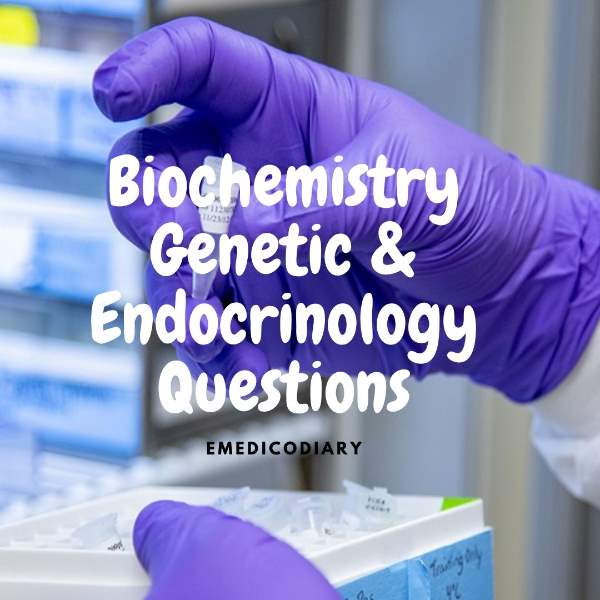Genetics
- Draw the structure of thymine.
- What is the central dogma of life? State the functions of nucleotide.
- Define replication of what is the enzyme of replication mentions their function.
- What is the genetic code? What are the features of genetic code? mention types of mutations.
- Draw and label RNA. Mention the difference among major types of RNA.
- Define replication. What are its requirements? How the replication bubble is formed.
- Describe the initiation step of translation. What is the post-translational modification?
- What are the salient features of the structure of DNA? What is the difference between DNA and RNA?
- What is the central dogma of life?
- State the functions of nucleotide.
- Mention the functions of the enzyme of replication.
- What are the features of genetic code?
- What is the genetic code?
- Define transcription, Watson crick model of DNA.
- What are the components of replication?
- What is point mutations? Define southern and northern blotting. Mention their applications.
- Mention the type of mutation. Cause of mutations.
- Define transcription.
- State the significance of reverse transcription.
- What is the pre translational and post-translational modification?
- SN: i) DNA library ii) recombinant DNA.
- Draw and label tRNA.
- Mention the difference between three major types of RNA.
- Describe the initiation step of translation.
- Mention the salient features of DNA with a diagram.
- What are the differences between DNA AND RNA?
- Define codons and anticodons.
- Name the initiation and termination codons.
- What are the requirements of translation?
- Define mutations. Mention the consequence of mutations.
- What is recombinant DNA technology? State the importance and step of PCR.
- Mention the functions of each arm of tRNA.
- What are the regulatory sequences of transcription? Mention their location and function.
- Write in short about the termination steps of transcription.
- What is the difference between purines and pyrimidine? Mention the metabolic derangement in insulins' lack.
- What is the nucleosome DNA repairing mechanism?
- How DNA is organized in the chromosome.
- Give the difference between PCR and biological cloning.
- Write in short about salvage pathways of purine nucleotide.
- Difference between genome and chromosome.
- Compare different forms of DNA short note: PCR.
- Mention the steps of DNA replication
- State the Mandel’s law of inheritance.
- Give the basic chemistry of nucleic acid. Define gene and genome.
- What is the transcription unit?
- Write the steps of insulin biosynthesis. Mention its deficiency effect on lipids metabolism.
- What is the type of RNA polymerase? Mention their function
- Difference between i) replication and transcription ii) genetic code and codon iii) sense codon and nonsense codon iv) point and frameshift mutations
- Define gene. What is it’s regulatory sequences? Mention their location. What is RELP?
- Define translation. What are the requirements of translation?
- What do you mean by telomeres DNA fingerprinting?
- Define translation.
- Draw and label cycle with the function of each phase.
- State the difference between DNA AND RNA synthesis.
- Explain the wobble hypothesis. Why replication is a caned semi-conservative process.
- What are the steps of protein synthesis? Classification of RNA and function.
- Post-transcriptional modification of Eukaryotes
- What are the processes of amplification of DNA fragments?
- Type of RNA with their function.
Endocrinology
- Define hormones.
- Classify hormones with examples.
- Function of aldosterone
- The function of cortisol.
- What is thyroid function tests?
- Describe the mechanism of action of glucagon.
- Write the indication, preparation of patients and procedures of OGTT.
- Mention the metabolic function of the thyroid hormone.
- How TSH influences the increased synthesis of thyroid hormone.
- Write down the functions of insulin.
- Write down the mechanism of action of protein hormones.
- Discuss in short the synthesis thyroxin.
- Explain the biosynthesis of insulin.
- What are thyroid hormone disorders?
- What are the difference between dwarfism and cretinism?
- How G protein-like receptor-activated?
- Name the diabetogenic and anti-diabetogenic hormones.
- Mention the consequence of insulin deficiency in CHO and fat metabolism.
- Mention the hormonal control of calcium homeostasis.
- Why tetany occurs in alkalosis
- Name the glucocorticoid.
- Discuss in short the role of insulin in fatty acids and proper metabolism.
- The function of ADH.
- Enumerate the thyroid function tests.
- Enumerate the ketogenic hormones.
- How the thyroid hormone acts.
- Mechanism of action of steroid hormones.
- Biosynthesis of urine. Hormones Essential for Life.
- Name the biochemical aspect of tetany.
- Interpret the results of OGTT.
- Mention the form of blood Ca++.
- Name the hormones of the pancreas.
- Mention the effect of cortisol on inflammation
- SN: i) Addison disease ii) pituitary diabetes iii) adrenal insufficiency iv) Cushing syndrome v) dwarfism vi) SI units.
- What is SI units? How solutions concentration can be expressed? Calculate molarity and osmolarity?.
- Mechanism of action of steroid hormones.
- Hormones adrenal gland.
Also read: Biochemistry Questions & Answers
Also read: Question Collection

Comments (0)